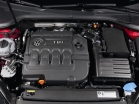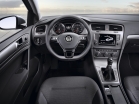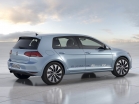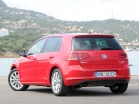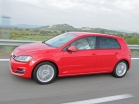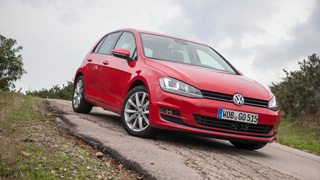Volkswagen Golf VII 5 doors since 2012 Hatchback test drive
Father and children
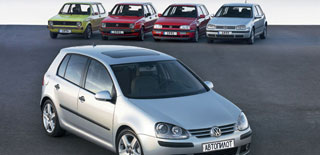 Does the reputation of the ancestor oblige to stay within the concept of the concept? .. Fidelity does not interfere with the creation of modern cars, such as Volkswagen Golf v.
Does the reputation of the ancestor oblige to stay within the concept of the concept? .. Fidelity does not interfere with the creation of modern cars, such as Volkswagen Golf v. Eh, you are heavy, Monomakh’s hat ... If Golf knew how to speak, we would probably have heard something similar from him. Is it a joke, to be the father of a whole class: after all, there is not only rights, but also duties a whole bunch of problems, responsibility ...
In our cynical and mercantile time, we reason more dryly and scientific. The promoted brand, on the one hand, simplifies the life of a new product, more precisely, its manufacturers and sellers. On the other hand, this product should not deceive the expectations of potential buyers and customers. Here, let's say, everything is quite simple with TVs: each new generation should be wider, more colorful and thinner than the previous one. What about cars? ..
Classic during life. The requirements for the car are much more diverse, simple solutions are not always appropriate. In marketing circles, a terrible professional definition of cannibalism was born. If you follow it, then, for example, to increase the internal space, one could make the fifth generation of Golf a little more like minivan. But this could distract customers from another VW model - Touran, made on the basis of the same Golf. In addition, this would contradict the expectations of buyers who, as the experience of the previous three generations shows, tend to expect at least the continuity of style from the new machine.

The designers had to tinker with Golf V: on the one hand, something modern should be done, on the other hand, the connection of times should not be interrupted. The task has been completed: firstly, the new most massive Volkswagen does not look outdated against the background of its classmates, and secondly, if you shoot a cartoon with golf IV flow into Golf V, it is unlikely that you need to draw many intermediate frames. Although, if we recall the story, the animation of the conversion of the first generation into the second did not at all require intermediate series - and they were shared for nine years.
In fact, in reality, our father today less resembles his own predecessor than in photographs. Yes, the proportions of the body have changed somewhat, yes, the characteristic bend of the rear rack panel is not so striking as on Golf IV. And the elegantly defiled hood and the rapid form of the facing of the front line look like the implementation of those very hints of dynamics and the classic style, which Golf-Klasse could only dream of a great-great-great-great-great-grandmother: only the ribs of stiffness were laid. In the position of a rich offspring, there are still their advantages.
Life was a success! To begin with, the new Golf has grown: even by eye, lengthening of the base by only 55 mm and a height by 39 mm is noticeable. This was most favorable in the vast salon: the back is now no less spacious than on many German models of a higher class.
However, now few people can be surprised by an increase in space: from the new model we expect a new suspension, new engines, boxes, and increasing the hardness of the body to twist. And Golf V is all right with this. Let's say the back suspension is not just new, but fundamentally new. The place of the once revolutionary in its simplicity is a semi -dependent (with a tesped beam by longitudinal levers) the suspension was occupied by an independent multi -link. In addition to the obvious advantages, it is also good in that the rear axle drive harmoniously fits into it: earlier the suspension of the same scheme was used on the Golf 4 Motion, unlike front -wheel drive options.
The hardness of the body is not only increased, but increased by 80%, to 25 kN/degrees, that is, almost to the level of sports models. A set of gearboxes is supplemented by 6-speed mechanical, as well as DSG and Tiptronic, which we are familiar with thanks to Audi. In general, despite the obvious desire to preserve the image of a classic car for the middle class, Golf clearly intends to compete for a place in the hearts and money in wallets by a non -burdened family, but carried away by emotions of youth.
The latter, however, will also have to pay for safety and comfort. The standard completion of the version of even the most modest performance - Trendline - includes an electronic ESP stabilization system, four pillows in front, pouting curtains on windows, electric windows, a central lock with remote control, electric drive and heating of mirrors. Do not you find that this Volkswagen has become reminiscent of Audi? And if you pay attention to the elegant chrome decoration of some details in expensive performance - Comfortline and Sportline - the analogy becomes obvious, although such an increase in the well -being of a separate model is completely filed in general trends. However, competitors still leave more modest versions in the range. However, for those who want to save VW, they exist in the Polo and Lupo model range, and the entire Volkswagen AG concern - SEAT and SKODA brands.
Three letters. Now two gasoline engines are available to potential buyers of Golf. A modest 1.4-liter capacity of 75 hp with conventional fuel injection and 1.6-liter with a capacity of 115 hp. With direct injection of gasoline into the FSI cylinder (Fuel Stratified Injection). To the debut of the model in our market, which is scheduled for March next year, mirror versions will be added: 90-horsepower 1.4 l FSI and normal 1.6-liter with a capacity of 102 hp. And later, a two-liter FSI will appear with a capacity of 150 hp, which will be installed only on top versions for some time, and only in the future they promise to ignite some kind of sports power unit. It is easy to guess that the main candidate is a 3.2 -liter six from Audi. The choice of diesel engines will also be expanded: to the current TDI 1.9 liters (105 hp) and 2.0 liters (140 hp) atmospheric SDI 2.0 liters with a capacity of 75 hp.

The FSI manufacturers' rate looks quite logical: the direct injection of gasoline gives an increase of one and a half dozen forces and at the same time reduces the fuel consumption - primarily in the city - as well as the release of toxic substances. One but: such motors are sensitive to fuel quality, in particular, to sulfur content. However, diesel engines are also remarkable. The issue was solved simply with this: for engines that operate in difficult conditions (Russian) have established abbreviated intervals of TO. This is somewhat addictive for the operation of the car, but you have to pay for all the good.
But about such an abbreviation as the GUR (power steering), the owners of golf classes, apparently, will soon have to forget. The power steering is slowly removed from the circulation: more and more new models are equipped with either a hydroelectric or simply electric steering mechanism. The electric drive does not pick up the parts of the engine constantly, but spends energy only when necessary, and on Golf, for example, this allows you to reduce the consumption by about 0.2 l/100 km.

Review. This very amplifier is perhaps the only unit that deserves comments. At speeds above 150-160 km/h, even on an absolutely flat autobahn, it was necessary to constantly adjust the trajectory of movement with the steering wheel. But the designers assured that the electronic and mechanical nodes of the steering are configured precisely from the point of view of increasing the stability of movement in a straight line. Although you can believe the press release: such instability was noticeable only on the relatively modest Golf 1.4 FSI and was practically absent at the most powerful two-liter diesel version today. The difference here is not only in the power and mass of the power unit, but also in the fact that 2.0 TDI we got in a more expensive performance and, most importantly, with a low profile tires - 60% versus 65%. So instability can be attributed to the tire account, but the high -profile is noticeably more comfortable, which is more important for our conditions.
Text Valery Chusov, photo by Andrei Gordasevich and VW AG
Model/Modification Volkswagen Golf 1.4 FSI Volkswagen Golf 2.0 TDI
Manufacturer/country Volkswagen AG/Germany Volkswagen AG/Germany
Number of doors/places 5/5 5/5
ENGINE
Type/number/location of gasoline cylinders/4/in -line turbodiesel/4/in -line
Working volume (cubic meter) 1390 1968
Power (kW (lp) at about./Min.) 66 (90) at 5200 103 (140) at 4000
Moment (Nm at about./Min.) 130 at 3750 320 at 1750-2500
TRANSMISSION
Front front drive
Gearbox mechanical 5-speed mechanical
Brakes, safety
Front/rear ventilated disk/disk ventilated disk/disk
Assisting electronic systems ESP (vkl. ABS, EBD, Brake Assist, etc.), PBS ESP (VKL. ABS, EBD, Brake Assist, etc.) PBS
Frontal, lateral, curtains (6) frontal, side, side, curtains (6)
Dimensions/mass
Length/width/height (mm) 4204/1759/1485 4204/1759/1485
Wheel base/clearance (mm) 2578/no data 2578/no data
Tires 195/60 R15 195/65 R15
Mass weight/full (kg) 1201/1790 1318/1910
The volume of the fuel tank (L) 55 55
Maximum speed (km/h) 174 203
Acceleration to 100 km/h (sec.) 12.9 9.3
Fuel consumption (city/highway, l/100 km) 8.3/5.1 7.1/4.5
The price in Moscow is $ 17,900 (approximately) $ 20,000 (approximately)
Source: "Autopilot"

